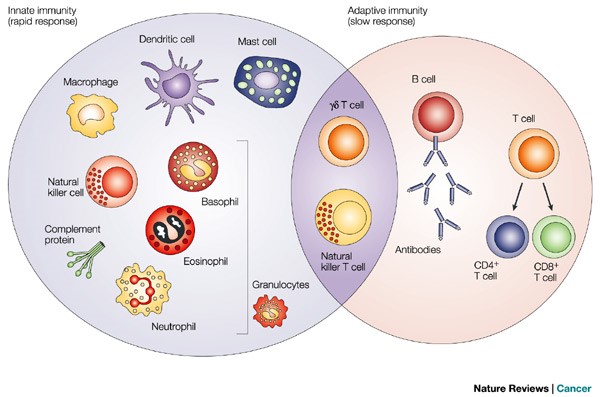The human immune system is an incredible, complex, and ever-changing network of cells throughout the body. Every day we encounter pathogens - bacteria, viruses, fungi, and protozoa - that would love to infect us and make our bodies their new homes. And yet, for the most part we live healthy, unaffected lives.
How does our body defend us against the constant opposition? Through two types of immunity: innate and adaptive.
Our innate immunity refers to, you guessed it, the immunity we are born with! It is the simplest form of immunity, and is responsible for the general, non-specific barriers to pathogens that the body puts up. Its response is rapid, and begins to fight against pathogens almost immediately.
Our adaptive immunity develops over time and is unique to each individual. As you encounter new pathogens your body learns to recognize them and stores this information so that if you encounter that same pathogen again your body can mount a stronger and quicker immune response. The first time your body encounters a pathogen it takes approximately 4 days for your adaptive immunity to begin working. Each time after that your body becomes more effective and rapid in its response; this occurs to the point that eventually you may encounter a pathogen and your body will fight it off before you ever even feel ill.
Both the innate and adaptive immune systems are activated by a genetic system called the Major Histocompatibility Complex (MHC) which presents pathogenic proteins to the cells in our immune system. This activates the cells to attack the pathogen. The cells are able to discern between the proteins from pathogens and our own proteins. This is because bacteria, viruses, fungi, and protozoa all contain various proteins that do not exist in our bodies - similar to the way we would recognize a sports team that is wearing a different colored jersey. And much like in sports, the best offense is a good defense.
So who are these key defensive players in the immune system?

Innate Immune System:
Dendritic Cells: Referred to as an antigen-presenting cell because it is responsible for presenting pathogenic peptide fragments to other cells in the immune system.
Macrophages: These cells reside within the tissues and are responsible for phagocytosis - engulfing - of the invading cell, digesting it, and then breaking it down into smaller proteins to be presented to other cells via the Major Histocompatibility Complex (mentioned above). Also an antigen-presenting cell.
Major Histocompatibility Complex (MHC): Takes small protein fragments from pathogens and pushes them to the cell surface to be presented to other immune cells.
Interferons: These proteins are incredibly important to your innate immune system and act to prevent the replication of viruses and to increase the activity of MHC molecules.
Complement Proteins: Act to break down the cell walls of bacteria which causes them to become porous; the influx or outflux of fluids with the surrounding environment causes them to burst or wither, respectively.
Natural Killer Cells: Sometimes pathogens find a way to evade the cells of the immune system; natural killer cells are able to detect when viral cells have changed the process of the MHC complex and will target these specific cells and induce apoptosis - cell death - so that the virally infected cell cannot continue to wreak havoc on the body.
Granulocytes: A class of three molecules involved in nonspecific immune defenses. • Neutrophils target bacteria and, in essence, follow them back to their source to mark them for destruction by B cells. An accumulation of neutrophils at the site of a wound is responsible for the creation of pus. • Eosinophils and Basophils release histamine during an allergic reaction. Histamine allows an increased flow of blood through the blood vessels, which in turn allows immune cells to flow more freely through the body.
Adaptive Immune System:
The adaptive immune system is much more complicated in its workings, but at a basic level there are two main cells:
B Cells: White blood cells, lymphocytes, which have numerous sites on their outside surface that can identify various pathogenic proteins and organic matter. Once these B-cell receptors have identified a specific antigen they will bind to it and begin to rapidly multiply, these newly replicated cells are referred to as antibodies. Once these antibodies are created they will be pathogen specific, and will seek out any of those pathogenic cells and mark them for destruction. This is one way that your body tries to protect you from getting sick from the same illness twice.
T Cells: These cells react specifically to pathogens which have already entered and infected the cells in your body; namely viruses and cancer cells. The T Cells will attach to the infected cell and begin the destruction of the whole cell. These cells are also pathogen specific, and will attack based on the presence of specific antigens. T Cells are also active in the signalling of other immune cells to a site of infection.
So, the next time you are feeling sick and miserable…remember to treat your body right and let the immune system do what it does best: fight for you!
Margo Henkhaus
Sources- http://www.biology.arizona.edu/immunology/tutorials/immunology/page3.html
- http://www.ncbi.nlm.nih.gov/books/NBK26846/
- http://www.novimmune.com/science/innate.html
- http://www.novimmune.com/science/adaptive.html
- image: http://www.nature.com/nrc/journal/v4/n1/fig_tab/nrc1252_F1.html